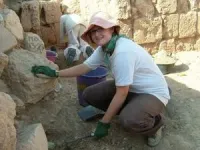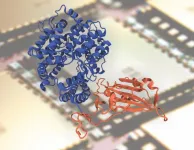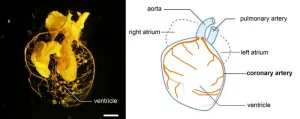(Press-News.org) For the first time, a group of researchers have successfully extracted ancient DNA from a 2,900-year-old clay brick.
The analysis provides a fascinating insight into the diversity of plant species cultivated at that time and place, and could open the way to similar studies on clay material from other sites and time periods.
The results are published today in Nature Scientific Reports.
Currently housed at the National Museum of Denmark, the clay brick originates from the palace of Neo-Assyrian king Ashurnasirpal II, in the ancient city of Kalhu. Known today as the North-West palace in Nimrud (modern-day northern Iraq), its construction began around 879 BCE. The brick has a cuneiform inscription (written in the now extinct Semitic language Akkadian) stating that it is ‘The property of the palace of Ashurnasirpal, king of Assyria.’ This makes it possible to date the brick precisely to within a decade (879 BCE to 869 BCE).
During a digitalization project at the Museum in 2020, the group of researchers were able to obtain samples from the inner core of the brick - meaning that there was a low risk of DNA contamination since the brick was created. The team extracted DNA from the samples by adapting a protocol previously used for other porous materials, such as bone.
After the extracted DNA had been sequenced, the researchers identified 34 distinct taxonomic groups of plants. The plant families with the most abundant sequences were Brassicaceae (cabbage) and Ericaceae (heather). Other represented families were Betulaceae (birch), Lauraceae (laurels), Selineae (umbellifiers) and Triticeae (cultivated grasses).
With the interdisciplinary team comprising assyriologists, archaeologists, biologists, and geneticists, they were able to compare their findings with modern-day botanical records from Iraq as well as ancient Assyrian plant descriptions.
The brick would have been made primarily of mud collected near the local Tigris river, mixed with material such as chaff or straw, or animal dung. It would have been shaped in a mould before being inscribed with cuneiform script, then left in the sun to dry. The fact that the brick was never burned, but left to dry naturally, would have helped to preserve the genetic material trapped within the clay.
Dr Sophie Lund Rasmussen (Wildlife Conservation Research Unit, Department of Biology, University of Oxford), joint first author of the paper, said: ‘We were absolutely thrilled to discover that ancient DNA, effectively protected from contamination inside a mass of clay, can successfully be extracted from a 2,900-year-old clay brick. This research project is a perfect example of the importance of interdisciplinary collaboration in science, as the diverse expertise included in this study provided a holistic approach to the investigation of this material and the results it yielded.’
In addition to the fascinating insight this individual brick revealed, the research serves as a proof of concept and method which could be applied to many other archaeological sources of clay from different places and time periods around the world, to identify past flora and fauna. Clay materials are nearly always present in any archaeological site around the world, and their context means they can often be dated with high precision.
This study only described the plant DNA extracted, as these were the most prevalent and best-preserved specimens. However, depending on the sample, all taxa could potentially be identified, including vertebrates and invertebrates. The ability to provide accurate descriptions of ancient biodiversity would be a valuable tool to better understand and quantify present day biodiversity loss, and to gain a deeper understanding of ancient and lost civilisations.
‘Because of the inscription on the brick, we can allocate the clay to a relatively specific period of time in a particular region, which means the brick serves as a biodiversity time-capsule of information regarding a single site and its surroundings. In this case, it provides researchers with a unique access to the ancient Assyrians’ said Dr Troels Arbøll, joint first author of the paper and junior research fellow at Faculty of Asian and Middle Eastern Studies, University of Oxford, when the study was conducted.
Notes to editors:
For media requests and interviews, contact Dr Sophie Lund Rasmussen: sophie.rasmussen@biology.ox.ac.uk. Images of the clay brick are available on request.
The study ‘Revealing the secrets of a 2900‑year‑old clay brick, discovering a time capsule of ancient DNA’ will be published in Nature Scientific Reports at 10 am BST, Tuesday 22 August, 2023: https://doi.org/10.1038/s41598-023-38191-w. To view a copy of the manuscript before this under embargo, contact Dr Sophie Lund Rasmussen: sophie.rasmussen@biology.ox.ac.uk
The research was conducted in collaboration with Troels Pank Arbøll from Department of Cross-Cultural and Regional Studies, University of Copenhagen; Sophie Lund Rasmussen from the Wildlife Conservation Research Unit, Department of Biology, University of Oxford; Anne Haslund Hansen from Modern History and World Cultures, National Museum of Denmark; Nadieh de Jonge, Cino Pertoldi and Jeppe Lund Nielsen from Department of Chemistry and Bioscience, Aalborg University and Aalborg Zoo (CP).
About the University of Oxford
Oxford University has been placed number 1 in the Times Higher Education World University Rankings for the seventh year running, and number 2 in the QS World Rankings 2022. At the heart of this success are the twin-pillars of our ground-breaking research and innovation and our distinctive educational offer.
Oxford is world-famous for research and teaching excellence and home to some of the most talented people from across the globe. Our work helps the lives of millions, solving real-world problems through a huge network of partnerships and collaborations. The breadth and interdisciplinary nature of our research alongside our personalised approach to teaching sparks imaginative and inventive insights and solutions.
Through its research commercialisation arm, Oxford University Innovation, Oxford is the highest university patent filer in the UK and is ranked first in the UK for university spinouts, having created more than 200 new companies since 1988. Over a third of these companies have been created in the past three years. The university is a catalyst for prosperity in Oxfordshire and the United Kingdom, contributing £15.7 billion to the UK economy in 2018/19, and supports more than 28,000 full time jobs.
About Oxford University’s Wildlife Conservation Research Unit (WildCRU)
Founded in 1986, Oxford University’s Wildlife Conservation Research Unit (WildCRU) was the first university-based conservation research unit in Europe. Today we are recognised as a world leader in our field, conducting cutting-edge, original research to inform conservation based on excellent science. Our approach is empirical, interdisciplinary and collaborative. Our work underpins conservation strategy, informs project implementation and supports policy change at local and international levels. Our members have been drawn from more than thirty countries and our projects have a similarly international reach, ranging from the Scottish Highlands to Mongolia, West Africa and Borneo. The need for our efforts is greater than ever.
END
Researchers extract ancient DNA from a 2,900-year-old clay brick, revealing a time capsule of plant life
2023-08-22
ELSE PRESS RELEASES FROM THIS DATE:
Exascale revolution: Supercomputers unleash a new era in biophysics discovery
2023-08-22
In a recently published article featured on the cover of the Biophysical Journal, Dr. Rafael Bernardi, assistant professor of biophysics at the Department of Physics at Auburn University, and Dr. Marcelo Melo, a postdoctoral researcher in Dr. Bernardi's group, shed light on the transformative capabilities of the next generation of supercomputers in reshaping the landscape of biophysics.
The researchers at Auburn delve into the harmonious fusion of computational modeling and experimental biophysics, providing a perspective for a future in which discoveries ...
Origins of coronary arteries
2023-08-22
Coronary arteries are a vital part of the human heart, providing it with oxygen-rich blood so that it can work. By comparing the hearts of mammals, birds, reptiles, fish and frogs, a multi-institutional team of researchers appears to have found evidence that the structure of our hearts evolved in a stepwise process from fish, through amphibians to reptiles to mammals. When animals evolved from living in the water to living on land, a significant remodeling of the blood vessels to the heart occurred, enabling survival without gills. Understanding ...
Novel research reveals existence of altered mesocortical connectivity in obesity
2023-08-22
ROCKVILLE, Md.—For the first time, researchers have discovered that the ventral tegmental area (VTA) of the brain—a key structure involved in motivation and reward appreciation has altered connectivity patterns with specific brain regions in patients with obesity. Individuals with obesity have hyper-connectivity of the VTA with part of the ventral occipitotemporal cortex (visual processing for food images) and hypo-connectivity with the left inferior frontal gyrus (associated with cognitive control), according to a new study in Obesity, ...
Study confirms long-term benefits of weight loss surgery in the prevention of cancer
2023-08-22
ROCKVILLE, Md.—After adding follow-up years, increased sample sizes and examining multiple surgical procedures, new research shows bariatric surgery is associated with lower all-cancer and obesity-related cancer incidence among females. The research also found that cancer mortality was significantly lower among female surgical patients compared to non-surgical subjects, according to a new study in Obesity, The Obesity Society’s (TOS) flagship journal.
Although population studies have established a positive association between body mass index and cancer incidence, less clear is whether voluntary ...
Heart attack patients should take aspirin to avoid a new heart attack, stroke and death
2023-08-22
Amsterdam, Netherlands – 22 Aug 2023: Heart attack patients who do not take daily aspirin have an elevated likelihood of recurrent myocardial infarction, stroke or death compared with those who consistently take the drug, according to research presented at ESC Congress 2023.1
“Our findings suggest that not taking aspirin as prescribed after a heart attack is linked to a higher risk of having another heart attack, a stroke or dying,” said study author Dr. Anna Meta Kristensen of Bispebjerg and Frederiksberg Hospital. Frederiksberg, Denmark. ...
Heart attack victims who recognise symptoms are less likely to die in hospital
2023-08-22
Amsterdam, Netherlands – 22 Aug 2023: Recognising and acting on heart attack symptoms is linked with faster life-saving treatment, according to research presented at ESC Congress 2023.1
“Patients with a repeat heart attack were more likely to know the symptoms than first-time sufferers, but recognition was low in both groups,” said study author Dr. Kyehwan Kim of Gyeongsang National University Hospital, Jinju, Republic of Korea. “Most patients could identify chest pain but less than one-third knew the other symptoms.”
Heart attack symptoms can include chest pain, radiating pain to the arms, jaw and neck, dizziness, ...
Keep fit to avoid heart rhythm disorder and stroke
2023-08-22
Amsterdam, Netherlands – 22 Aug 2023: A study in more than 15,000 people has found that physical fitness is linked with a lower likelihood of developing atrial fibrillation and stroke. The research is presented at ESC Congress 2023.1
Atrial fibrillation is the most common heart rhythm disorder, affecting more than 40 million people worldwide.2 It is estimated that one in three Europeans will develop atrial fibrillation in their lifetime. Patients with the condition have a five-fold higher risk of stroke ...
City-living may make male song sparrows more doting ‘super’ fathers
2023-08-22
When animals settle in new environments, or when their natural habitats are rapidly changed by human influence, their behaviors change. One such behavioral change that has been observed in several bird species that settled in cities is increased aggression, born out of the need to defend territories.
City-living sparrows have, due to lower species density, fewer encounters with their kin than in the countryside. Yet, urban song sparrows have been shown to be consistently more aggressive in defending their territories. Now, a team of researchers in the US has investigated the effects of urbanization and the associated ...
Topology's role in decoding energy of amorphous systems
2023-08-22
Osaka, Japan – How is a donut similar to a coffee cup? This question often serves as an illustrative example to explain the concept of topology. Topology is a field of mathematics that examines the properties of objects that remain consistent even when they are stretched or deformed—provided they are not torn or stitched together. For instance, both a donut and a coffee cup have a single hole. This means, theoretically, if either were pliable enough, it could be reshaped into the other. This ...
Small urban greening projects can dramatically increase number of insect species in cities
2023-08-22
By increasing the diversity of indigenous plants in urban areas, researchers from the University of Melbourne have seen a seven times increase in the number of insect species in just three years, confirming the ecological benefits of urban greening projects. The findings are published in the British Ecological Society journal, Ecological Solutions and Evidence.
The study, conducted in a small greenspace in the City of Melbourne, found that an increase in the diversity and complexity of plant communities leads to a large increase in insect biodiversity, a greater ...





